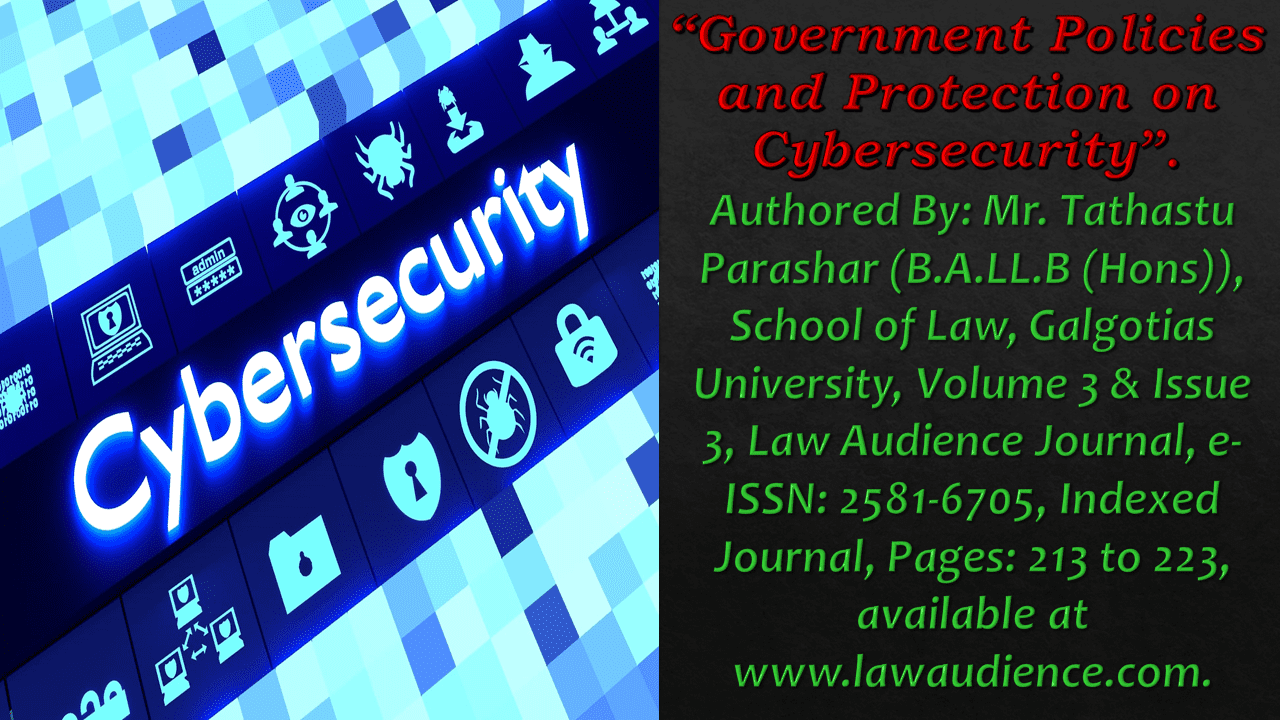Click here to download the full paper (PDF)
Authored By: Mr. Tathastu Parashar (B.A.LL.B (Hons)), School of Law, Galgotias University,
Click here for Copyright Policy.
ABSTRACT:
“Network safety assumes a significant part in the field of data innovation. Securing the data have become probably the greatest test in the current day. At whatever point we contemplate the digital protection the principal thing that strikes a chord is digital wrongdoings which are expanding enormously step by step. Different Governments and organizations are going to numerous lengths to forestall these digital violations. Other than different measures digital protection is as yet an exceptionally huge worry to many. It investigates how difficulties for network safety are likewise difficulties for security and information insurance, thinks about how digital protection strategy can influence protection, and notes how the internet administration and security is a worldwide issue.
This paper basically centres around difficulties looked at by network safety on the most recent advancements. It likewise centres around most recent about the digital protection methods, morals and the patterns changing the substance of network protection. Online protection is the protection of web related structures like gear, programming and data from cyber threats. The preparation is used by individuals and tries to guarantee against unapproved induction to server ranches and other electronic structures”.
I. IMPORTANCE OF CYBER SECURITY:
- Application security
- Information or data security
- Network security
- Disaster recovery/business continuity planning
- Operational security
- Cloud security
- Critical infrastructure security
- Physical security
- End-user education
Maintaining cybersecurity in a continually advancing danger scene is difficult for all associations. Conventional responsive methodologies, in which assets were set toward ensuring frameworks against the greatest known dangers, while lesser realized dangers were undefended, is as of now not an adequate strategy. To stay aware of changing security hazards, a more proactive and versatile methodology is fundamental. A couple of key organization security cautioning affiliations offer heading. For instance, the National Institute of Standards and Technology (NIST), suggests taking on constant checking and continuous evaluations as a component of a danger appraisal structure to shield against known and obscure dangers.
II. THE ADVANTAGES OF CYBERSECURITY:
The advantages of executing and Maintaining cybersecurity rehearses include:
- Business assurance against cyberattacks and information breaks.
- Assurance for information and organizations.
- Counteraction of unapproved client access.
- Further developed recuperation time after a break.
- Security for end clients and endpoint gadgets.
- Administrative consistency.
- Business congruity.
- Further created trust in the association’s standing and trust for planners, accessories, customers, accomplices and representatives ULD.
III. TYPES OF CYBERSECURITY:
The way toward staying aware of new advances, security patterns and danger insight is a difficult errand. It is important to shield data and different resources from cyber threats, which take many structures. Sorts of cyber threats include[1]:
- Malware is a type of malevolent programming where any record or program can be utilized to hurt a PC client.
- Ransomware is another sort of malware. It includes an aggressor locking the casualty’s PC framework documents – regularly through encryption – and requesting an instalment to decode and open them.
- Social engineering is an assault that depends on human communication to fool clients into breaking security systems to acquire delicate data that is normally ensured.
- Phishing is a kind of friendly planning where phony email or texts that seem as though those from decent or acknowledged sources are sent. Frequently irregular assaults, the plan of these messages is to take delicate information, for example, Visa or login data.
- Spear phishing is a sort of phishing assault that has a planned objective client, association or business.
- Insider Threats are security breaks or misfortunes brought about by people – for instance, workers, workers for hire or clients. Insider dangers can be vindictive or careless in nature.
- Distributed denial-of-service (DDoS) assaults are those wherein various frameworks upset the traffic of a designated framework, like a worker, site or other organization asset. By flooding the objective with messages, association solicitations or bundles, the aggressors can slow the framework or crash it, preventing authentic traffic from utilizing it.
- Advanced persistent threats (APTs) are drawn out designated assaults in which an aggressor penetrates an organization and stays undetected for significant stretches of time with the mean to take information.
- Man-in-the-middle (MitM) assaults are listening in assaults that include an assailant blocking and transferring messages between two gatherings who accept they are speaking with one another.
- Other normal assaults incorporate botnets, drive-by-download assaults, exploit units, malvertising, vishing, certification stuffing assaults, cross-webpage prearranging (XSS) assaults, SQL infusion assaults, business email compromise (BEC) and zero-day exploits.
IV. CHALLENGES RAISED IN CYBERSECURITY:
- Network safety is reliably tried by software engineers, data setback, security, danger the board and changing Cybersecurity frameworks. The quantity of cyberattacks isn’t relied upon to diminish sooner rather than later. In addition, expanded passage focuses for assaults, for example, with the appearance of the Internet of things (IoT), increment the need to get organizations and gadgets.
- Quite possibly the most tricky components of cybersecurity is the advancing idea of safety hazards. As new advances arise, and as innovation is utilized in new or diverse manners, new assault roads are created. Remaining mindful of these perpetual changes and advances in attacks, similarly as invigorating practices to get against them, can be trying. Issues incorporate guaranteeing all components of network safety are ceaselessly refreshed to ensure against possible weaknesses.
- Furthermore, associations can accumulate a great deal of expected information on people who utilize at least one of their administrations. With more information being gathered, the probability of a cybercriminal who needs to take Personally Identifiable Information (PII) is another worry. Associations ought to do what they can to forestall a cloud break.
- Cybersecurity projects ought to likewise address end-client instruction, as representatives may accidentally bring infections into the working environment on their workstations or cell phones. Normal security mindfulness preparing will assist representatives with doing their part in staying with their protected from cyberthreats.
- Another challenge to cybersecurity incorporates a deficiency of qualified cybersecurity work force. As the measure of information gathered and utilized by organizations develops, the requirement for network safety staff to dissect, oversee and react to episodes likewise increments. (ISC) assessed the working environment hole between required network safety occupations and security experts at 3.1 million.
V. CYBERSECURITY VENDORS AND TOOLS:
Vendors in the cybersecurity field regularly offer an assortment of safety items and administrations. Normal security apparatuses and frameworks include:
- Identity and access management (IAM)
- Firewalls
- Endpoint protection
- Antimalware
- Intrusion prevention/detection systems (IPS/IDS)
- Data loss prevention (DLP)
- Endpoint detection and response
- Security information and event management (SIEM)
- Encryption tools
- Vulnerability scanners
- Virtual private networks (VPNs)
- Cloud workload protection platform (CWPP)
- Cloud access security broker (CASB)
Notable online protection sellers consolidate Check Point, Cisco, Code42, CrowdStrike, FireEye, Fortinet, IBM, Imperva, KnowBe4, McAfee, Microsoft, Palo Alto Networks, Rapid7, Splunk, Symantec, Trend Micro and Trustwave.
VI. FINANCIAL ISSUES IDENTIFIED WITH CYBERSECURITY:
With the expansion in digitization, network safety has become a significant issue. The examination has discovered that enterprises are losing enormous measures of cash because of cybercrimes like IP misfortune, calculation exchanging, and harm to monetary and customer information. The cyber systems are unreliable while there is an expansion in the quantity of organization associations and gadgets. The people group of aggressors is turning out to be further developed by working on their procedures.
- Here, the economy of network safety goes about as a weakness to the digital environment as it favors the aggressors.
- Cyber-attacks are modest and effectively did.
- The overall revenues of assailants are liberal.
- Law implementation is for all intents and purposes non-existent as just 2% of the cybercriminals are arraigned.
- There is an awkwardness among monetary motivating forces as specific advances and strategies sabotage network protection, for example, distributed computing.
- Productive strategic approaches like BYOD (Bring Your Own Device) cause issues as for security.
VII. CYBER LAWS IN INDIA:
The Information Technology Act, 2000:
The Information Technology Act 2000 controls the utilization of program, PC frameworks, PC network remembering information and data for the electronic organization. It manages the evidentiary worth of electronic exchanges, advanced marks, cybercrimes, network safety and information security.
The Accompanying Offences Have Been Characterized Under The Act:
- Section 65: Tampering with PC source reports is culpable with detainment as long as 3 years, or fine up to ₹2 lakh, or both.
- Section 66: Computer related offences, for example, making PC assets do a capacity with an exploitative or deceitful goal to get unapproved access is culpable with imprisonment for a term of 3 years, or fine up to ₹5 lakh, or both.
- Section 66A: Sending hostile messages through correspondence administration is culpable for a term which might stretch out to 3 years with fine.
- Section 66B: Dishonestly getting or holding taken PC asset or specialized gadget is culpable with detainment for as long as 3 years, or a fine of ₹ 1 lakh, or both.
- Section 66C: Identity burglary by utilization of a special distinguishing proof element of someone else like electronic mark, secret word and so forth is culpable for a term as long as 3 years, and fine up to ₹ 1 lakh.
- Section 66D: Cheating by personation by utilizing PC assets is culpable for a term as long as 3 years and fine up to ₹ 1 lakh.
- Section 66E: Violation of protection through catching, distributing or communicating a picture of private spaces of an individual, regardless of their assent, will be culpable for a term as long as 3 years, or fine up to ₹ 2 lakh, or both.
- Section 66F: Whoever submits or contrives to submit cyberterrorism by compromising the trustworthiness, solidarity or power of the country, or striking dread among individuals of a nation through acquiring unlawful admittance to confined information or data set, disavowal of administration or presenting an infection and so on is culpable with detainment which might even reach out to detainment forever.
- Section 67A: Publishing or communicating material which contains physically unequivocal demonstrations in electronic structure is culpable for a term that might stretch out to the detainment of 5 years and fine up to ₹10 lakh. A resulting conviction is culpable for a term which might reach out to the detainment of 7 years and fine up to ₹10 lakh.
- Section 67B: Publishing or sending material portraying kids in physically express demonstrations in electronic structure is culpable with detainment for as long as 5 years and a fine of up to ₹10 lakh. A resulting conviction is culpable with detainment as long as 7 years and fine of ₹10 lakh.
- Section 67C: Preservation and maintenance of data by go-betweens is culpable with detainment as long as 3 years and a fine.
- Section 71: Misrepresentation by smothering realities from the Comptroller or the Certifying Authority for getting electronic mark or permit is culpable with detainment of as long as 2 years, or fine of ₹1 lakh, or both.
- Section 72: Breach of classification and protection by any individual in compatibility of the force presented under the IT Act is culpable with as long as 2 years of detainment, or fine of ₹1 lakh, or both.
- Section 72A: Disclosure of data in break of a legal agreement by an individual, for example, a delegate who has tied down admittance to individual data of someone else meaning to cause improper misfortune is culpable with as long as 3 years detainment, or a fine of ₹5 lakh, or both.
- Section 73: Publishing electronic mark endorsement with the information that it is bogus is culpable for as long as 2 years of detainment, or fine up to ₹1 lakh, or both.
- Section 74: Publishing electronic mark declaration for fake designs is culpable with detainment as long as 2 years, or fine up to ₹1 lakh, or both.
- Section 75: This Act will likewise be material for offences or contradictions submitted outside India.
VIII. NATIONAL CYBERSECURITY POLICY, 2013:
The archive of National Cybersecurity Policy 2013[2], diagrams a guide for the formation of a system to manage online protection at all levels all through the country. Its vision is to fabricate a protected digital biological system. The mission is to secure the information in the internet, fabricate the possibility to guarantee, forestall and manage digital dangers, and limit harm from digital wrongdoings through upgraded innovation, practice and interaction.
The methodologies under this approach incorporate the production of a protected digital environment through instruments for security dangers like National Computer Emergency Response Team (CERT-In) to facilitate network safety endeavors, emergency the board and crisis reactions. It additionally incorporates getting e-Governance by executing more extensive utilization of Public Key Infrastructure (PKI). It additionally incorporates ensuring basic data framework through the nodal office, the National Critical Information Infrastructure Protection Center (NCIIPC). It additionally envelops limit working through instruction and preparing programs for human asset advancement.
IX. RECENT STEPS TAKEN BY THE GOVERNMENT:
Cyber Surakshit Bharat Initiative[3]:
It was dispatched in 2018 to assemble wellbeing measures for Chief Information Security Officers (CISOs) and IT staff who are at the cutting edge in different government divisions.
National Cyber Security Coordination Centre (NCCC)[4]:
It was created in 2017 and this commanded for the web traffic to be checked, including little bits of data inside every correspondence for distinguishing constant digital dangers.
Cyber Swachhta Kendra[5]:
This was a stage presented in 2017 which permitted Internet clients to clear out infection and malware from their PCs.
Information Security Education and Awareness Project (ISEA)[6]:
Under this task, about 1.14 lakh individuals were prepared through 52 organizations to bring issues to light by exploration and schooling in its field.
International Cooperation:
India has attached with nations like the United States, Singapore, Japan, and so on to make a safe digital environment and has additionally consented to arrangements that will assist India to manage digital dangers adroitly.
X. SUGGESTIONS:
Cyberspace is a great threat to the economy. The risk to the web could be administered by taking the going with measures:
- Follow secure practices and empower the Internet of Things (IoT) with current apparatuses and updates with the best techniques.
- Ongoing knowledge and Artificial Intelligence are needed to manage the assaults of cybercrime.
- Spreading mindfulness about online protection regarding hazard the board and Information Technology.
- All inclusive adherence to digital standards and international law for guaranteeing dependable state conduct.
- There should be collaboration among countries for making secure the internet.
- Nations should put forth attempts towards preparing and building HR gifted in digital danger the executives.
- Making of discouragement abilities in the internet.
- All nations should put forth aggregate attempts to make a multi-partner model of administration and information economy which could assist with building a prosperous economy.
- There is a requirement for a worldwide show on the internet as network safety isn’t only a public yet a global issue.
XI. CONCLUSION:
Cyberspace is growing step by step with a synchronous expansion in network associations. With this, the danger of digital dangers is likewise expanding. The Information Technology Act, 2000 sets down different digital violations alongside their punishments and disciplines.
The country’s economy is the weakest region as a colossal sum is lost because of IP misfortune, assault on exchanging calculations, and so forth There is a requirement for more rigid measures to be taken at both the public and worldwide level. Mindfulness ought to be spread as for network protection and nations ought to reinforce their HR via preparing them to manage digital danger the board.
Also, digital dangers can be constrained by further developing information and comprehension, just as consolidating strategies to utilize assets admirably. Different nations have embraced measures like information sway, web administration, information localization and so on the public authority can work on the financial aspects of online protection by observing network safety occurrences and their reactions.
Cite this article as:
Mr. Tathastu Parashar, “Government Policies and Protection on Cybersecurity”, Vol.3 & Issue 3, Law Audience Journal (e-ISSN: 2581-6705), Pages 213 to 223 (1st February 2022), available at https://www.lawaudience.com/government-policies-and-protection-on-cybersecurity/.
Footnotes & References:
[1] What Is Cybersecurity, available at https://www.comptia.org/content/articles/what-is-cybersecurity.
[2] National Cyber Security Policy-2013, available at https://www.meity.gov.in/sites/upload_files/dit/files/National%20Cyber%20Security%20Policy%20%281%29.pdf.
[3] Cyber Surakshit Bharat Programme, available at https://www.meity.gov.in/writereaddata/files/Cyber%20Surakshit%20Bharat%20Brochure.pdf.
[4] National Cyber Coordination Centre (NCSC), available at https://www.civilsdaily.com/news/national-cyber-coordination-centre-ncsc/.
[5] Cyber Swachhta Kendra, more details are available at https://www.cyberswachhtakendra.gov.in/.
[6] ISEA: Information Security Education and Awareness, more details are available at http://www.isea.gov.in/.



